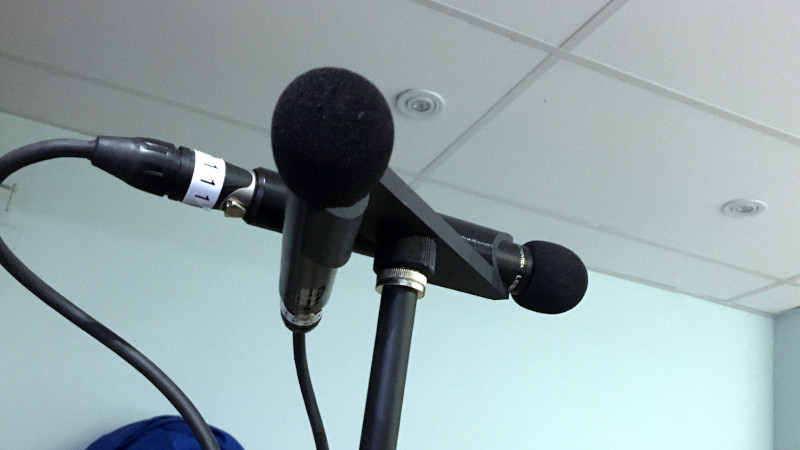When making a recording it can be surprisingly difficult to capture a good stereo image. A well-known technique is the ORTF microphone arrangement in which two cardoid microphones sit at 110 degrees to each other and 17cm apart, and thus pick up a readily reproducible stereo separation. It’s something that we’ve been known to do in our student days with a pair of Shure SM58s and a stack of Post Office elastic bands, but [marsairforce] has done a much nicer job with a very neat 3D-printed microphone clip.
Designed in OpenSCAD, the first iteration printed on a resin printer proved to be too brittle for the task, so a second version was printed on an FDM machine. This incorporated significant strengthening, as well as a screw mount for a microphone stand. The result is an extremely useful and cheap addition to any recording set-up, and anyone who has wrestled with achieving a good stereo image will appreciate it. You can see some of what went into it in the video below the break.
If this is your field of interest, you might also wish to look at a binaural microphone.
















Lots of effort for something that could be done in 30 minutes with a stick welder and few pieces of scrap steel.
How about 5 minutes with a piece of wood and a drill…
Or perhaps a stack of Post Office elastic bands… and we’re back to the beginning of the article.
Haha!
I wonder how long it will take before people start writing “not a hack” on articles where exclusively 3D prints ar being presented.
To be fair, welding (stick, TIG, MIG) is also additive manufacturing, and trees are one of the original 3D polymer printers.
And if you can weld but have access to a 3D printer?
It most likely wouldn’t have taken all that long to design and print, the difference is with a welder and scrap steel it wouldn’t look like it could be a finished marketable product, just saying this looks better than most other ways of hacking it together.
I don’t have a stick welder, would you be a sweetie and whip me a stereo mount?
Let’s respect the fact that not everyone has access to or the skills to use a welder. This is mostly a good “lessons learned” article.
One piece of sound advice I’d like to offer anyone considering stereo recording like this is that there are many many affordable condenser mics these days. The Shure SM-58 is the popular workhorse of dynamic vocal mics, but it is really designed for close mic’ing (and for dropping).
I like the AT Pro-37 for most instrumental recording. I wonder how they would do in this mount, particularly at further distances from the music source.
and SM-58 is a cardioid, not the best pattern for 3D recording…
This basic arrangement has been used since 1881!
I am just waiting for a 3D printed version of a human head for the ultimate recording mode 3D binaural. You can scan your own head for the perfect pickup which for you the best way to hear the reconstructed sound image.
mics built into a model head is not new either. 3d printed material would not have the acoustic characteristics as the material you head is made of so it would of course sound worse. The PS5 has some interesting phasing as a function of location work that you may like.
It’s … interesting. And would certainly make for a fast, repeatable ORTF stand. But I would want to incorporate some level of padding or shock absorption in the mic holders to help isolate any mechanical noise on the stand from the mics. This is also currently limited to just one diameter of mic.
It’s most common for pros and avid amateurs to carry a sort of ‘T’ bar with a central bushing to accept the stand’s threads. and two threaded bits that screw into any standard mic clip, that are free to slide anywhere along the bar. This allows the use of any mics (as long as they have clips), and you can achieve any of the close-spaced stereo mic arrays, from X-Y to ORTF.
https://cdn.shopify.com/s/files/1/0054/9466/9382/products/4f5856f695b8875d99bd17d34c499591.image.500x500_400x.jpg
Great job with this post! Definitely the FDM version is more appropriate at this time. Note that the resin was an organic water-washable resin that seems more applicable for small models and non-structural things. There are other resins available that would be more appropriate although the only real benefit would be “fit-and-finish” of the final product — it wouldn’t be any more functional.
I still can’t believe people waste their time designing and printing stuff like this…
This thing is 3 cylinders attached to a flat plate.
It could have been built out of wood/plastic/metal scraps and screws/bolts/glue in less time than this took to model, let alone print.